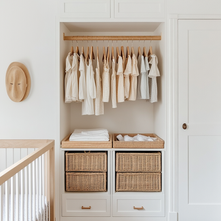How to Choose the Best Furniture for Small Spaces: 7 Smart Strategies from Interior Design Pros
- Beril Yilmaz

- Aug 14, 2024
- 6 min read
Updated: Mar 21

When you’re working with limited square footage, every piece of furniture counts. The challenge isn’t just about finding something that looks good—it’s about making sure that everything you bring into your home serves multiple purposes and fits seamlessly into the layout. Whether you’re furnishing a cozy apartment or a compact room in your house, picking the right affordable furniture for small spaces can make all the difference in creating a comfortable, functional, and stylish environment.
The good news? With a few smart strategies and the right pieces, you can transform even the tiniest of spaces into a well-designed haven. Below, we break down seven key tips for choosing the best furniture for small spaces, ensuring you get the most out of every square inch.
1. Opt for Multi-Functional Furniture

When space is tight, multi-functional furniture is your best friend. Think pieces that offer more than just one use—a sofa that turns into a bed, an ottoman that doubles as storage, or a coffee table that can be adjusted in height for dining. These versatile items allow you to maximize your space without sacrificing style.
For instance, a storage bench placed in the entryway can serve as both seating and a place to stash shoes, bags, and other essentials. Similarly, a lift-top coffee table can be used for both dining and working from home, making it perfect for those who need to save space but still want to live comfortably.
2. Prioritize Vertical Space

In small spaces, you might not have a lot of floor space, but you often have plenty of vertical room to work with. Use it! Tall bookshelves, wall-mounted storage units, and vertical cabinets can help you make the most of your walls, freeing up valuable floor space for other needs.
For example, instead of opting for a low TV stand, consider mounting your television on the wall and using floating shelves below it for additional storage. Or, use tall, narrow bookshelves to store books, decor, and other items without taking up too much floor space. This approach not only adds storage but also draws the eye upward, making the room feel taller and more spacious.
3. Choose Light, Airy Furniture

When furnishing a small space, it’s important to choose furniture that doesn’t overwhelm the room. Light-colored, open-frame furniture can make your space feel larger and more open. Opt for pieces with slim legs, glass tops, or transparent materials like acrylic to create a sense of openness.
For instance, instead of a bulky wooden coffee table, choose a sleek glass-top table with metal legs. Or, consider using a clear acrylic chair at your desk, which will practically disappear into the room, keeping the space feeling light and airy. These kinds of pieces help to reduce visual clutter and keep your space feeling open and inviting.
4. Invest in Modular Furniture

Modular furniture is another great option for small spaces because it can be easily reconfigured to suit your needs. Whether it’s a sectional sofa that can be arranged in different ways or a set of nesting tables that can be stored when not in use, modular pieces offer flexibility and adaptability.
For example, a modular sofa allows you to create different seating arrangements depending on the occasion, while nesting tables can be pulled out when you have guests and tucked away to save space when you don’t. This flexibility is key in small spaces, where you need to be able to adapt your layout to different needs and activities.
5. Go for Pieces with Built-In Storage

Storage is a constant challenge in small spaces, so it’s crucial to choose furniture that helps you keep clutter at bay. Look for pieces with built-in storage, such as beds with drawers underneath, coffee tables with hidden compartments, or sofas with storage ottomans.
A bed with built-in drawers is a great way to store clothes, bedding, or other items without needing additional furniture. Similarly, a coffee table with a lift-top or storage compartments can help you keep your living room tidy by providing a place to stash remotes, magazines, and other small items. These kinds of pieces help you make the most of your space while keeping your home organized and clutter-free.
6. Consider Scale and Proportion

In a small space, it’s essential to choose furniture that is appropriately scaled for the room. Oversized furniture can make a small room feel cramped and cluttered, while pieces that are too small can make the space feel empty and unbalanced.
When choosing furniture for small spaces, consider both the size and proportion of the pieces. For example, if you have a small living room, a loveseat or apartment-sized sofa might be a better fit than a full-sized couch. Similarly, instead of a large dining table, opt for a small round table that can accommodate a few chairs without taking up too much space. By choosing furniture that fits the scale of your room, you’ll create a more balanced and harmonious space.
7. Embrace the Power of Mirrors and Reflective Surfaces

Mirrors and reflective surfaces can be a game-changer in small spaces. They bounce light around the room, creating the illusion of more space and making the room feel brighter and more open. Consider placing a large mirror on one of your walls, or choosing furniture with mirrored or glass surfaces to enhance the sense of space.
For example, a mirrored console table in the entryway can create the illusion of depth, making the space feel larger than it is. Similarly, a glass dining table will keep the sightlines open, helping the room feel less cramped. By strategically using mirrors and reflective surfaces, you can make your small space feel bigger and more inviting.
1. What type of furniture is best for small spaces?
The best furniture for small spaces includes multi-functional pieces, such as a sofa bed, storage ottomans, and extendable tables. These items serve more than one purpose, helping you maximize your space without overcrowding the room.
2. How can I make my small living room look bigger?
To make a small living room look bigger, use light-colored, airy furniture with slim profiles. Incorporate mirrors and reflective surfaces to create the illusion of more space, and choose furniture with exposed legs to keep the room feeling open.
3. What are some space-saving furniture ideas for small bedrooms?
For small bedrooms, consider a bed with built-in storage drawers, wall-mounted nightstands, and foldable desks. Vertical storage solutions, such as tall bookshelves or floating shelves, can also help you make the most of limited space.
4. How do I choose the right size furniture for a small room?
When choosing furniture for a small room, consider both the scale and proportion of the pieces. Opt for compact furniture that fits the room’s dimensions without overwhelming the space. For example, a loveseat instead of a full-sized sofa or a small round dining table instead of a large rectangular one.
5. Can I use dark furniture in a small space?
While light-colored furniture is generally recommended for small spaces, dark furniture can work if balanced with lighter elements. Pair dark furniture with light walls, mirrors, and plenty of natural light to prevent the room from feeling too closed in.
6. How can modular furniture help in small spaces?
Modular furniture is highly versatile and can be reconfigured to suit different needs, making it ideal for small spaces. For example, modular sofas can be arranged in various layouts, and nesting tables can be stored when not in use, helping you adapt your space as needed.
7. What are the benefits of multi-functional furniture in small spaces?
Multi-functional furniture saves space by serving multiple purposes. For instance, a sofa bed provides seating during the day and a sleeping area at night, while a lift-top coffee table can double as a dining or work surface, making small spaces more versatile and efficient.
Choosing the right furniture for small spaces requires a bit of strategy, but with these tips in mind, you can create a home that’s both functional and stylish. From multi-functional furniture to modular pieces and smart storage solutions, there are plenty of ways to maximize your space without compromising on comfort or design.
So whether you’re furnishing a small apartment or trying to make the most of a compact room, remember that with the right furniture and a little creativity, you can create a space that feels just right for you.


































